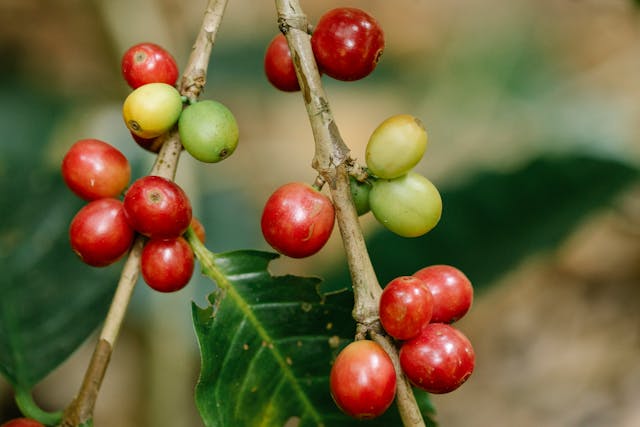
Brazilian Coffee: Small Cups, Big Flavor.
Brazilians keep their coffee game simple, no need for fancy specialty coffee here! Most coffee shops in Brazil only offer two main types of Brazilian coffee: the cafezinho and café com leite.
Forget fancy lattes and milky drinks! Brazil’s all about their cafezinho, a tiny cup of strong, filtered coffee served piping hot. It packs a flavor punch, way bolder than an espresso (even though it’s similar in size).
Here’s the thing, though – cafezinho isn’t made with pressure like espresso, so the taste is totally different.
The café com leite is a breakfast drink that’s the Brazilian version of the latte, that is commonly served as a cup of hot milk with the classic cafezinho added after.
There are other traditional coffee drinks such as:
- Galão: A creamy hot drink served in a tall glass made by adding foamed milk to espresso coffee, that consists of one quarter coffee and three quarters foamed milk.
- Carioca: which is a milder version of the cafezinho.
- Mazagran: A sweetened iced coffee beverage served with a slice of lemon.
Brazil and The Coffee Beans
Across the globe, Arabica beans rule the roost, making up about 70% of all coffee. Brazil’s no different – it’s mostly Arabica beans there too, especially in the big coffee-growing states like Minas Gerais.
Robusta, the stronger bean, is a smaller player in Brazil, mostly grown down south in Espírito Santo.

Brazilian coffee growing regions (arabica and robusta)
- Arabica (in yellow): Bahia, Minas Gerais, São Paulo, Paraná, Santa Catarina
- Robusta (in orange): Espírito Santo, Rio de Janeiro, Rondônia
Source: Brazilian coffee growing regions
Unlike countries like Italy where coffee is a way of life, Brazil is all about growing the good stuff. Don’t underestimate their coffee culture though! Here’s it all!
Brazil has 12 coffee-growing states and about 300,000 plantations! They’re the world’s top producer of both Arabica and Robusta beans, which is why they rule the coffee export scene. Brazil’s coffee production is so massive it affects everyone. If there’s a drought in Brazil, coffee prices everywhere might jump!

Portuguese: Sacos de café, Casa do Bandeirante, São Paulo, Brasil.
Source: Coffee production in Brazil.
Brazil’s Coffee Growing Regions

Credit: BSCA
Knowing where your Brazilian coffee comes from actually matters, different regions have different growing conditions which makes beans from the same species unique tastes and smells. The good thing about this is you can tell you how good the coffee might be.
Minas Gerais
The biggest coffee grower in Brazil, producing 50% of the country’s total beans! Their coffee’s famous for being full-bodied, with a delicious fruity aroma and a hint of citrus.
The producing regions within Minas Gerais are:
- Sul de Minas
- Cerrado de Minas
- Chapada de Minas
- Matas de Minas
São Paulo
Home to Port of Santos, Brazil’s infamous coffee exporting port. Has two growing regions:
- Mogiana
- Centro-Oeste de São Paulo
ESPÍRITO SANTO
The largest producer of Robusta beans in Brazil and also the second biggest coffee-producing state, in these regions:
- Montanhas do Espírito Santo
- Conilon Capixaba
BAHIA
The northeastern state is famous for producing quality beans and its application of high-tech in coffee beans processing and production.
- Cerrado and Planalto da Bahia
- Atlantico Baiano
PARANA
Coffee producers here are dominantly known for growing Arabica.
RONDONIA
Unlike coffee growers in Parana, coffee farms exclusively grow Robusta coffee.
For more detailed information on coffee growing regions in Brazil, visit here!
Brazilian Coffee Flavour Profiles
- Arabica Coffee: Brazilian Arabica has Low acidity, a smooth and creamy texture, and notes of chocolate, nuts, and fruit.
- Robusta Coffee: Brazilian Robusta coffee has a higher caffeine content than Arabica coffee and has a bold and bitter taste.
- Catuai coffee: A mix of two other bean types, Mundo Novo and Caturra. This gives it a smooth, medium-bodied taste that’s not too sharp or acidic. Basically, it’s a crowd-pleaser!
- Bourbon: Among the Arabica coffee family, Bourbon is known for being quite the contrary. It is smooth and easy to drink, with a flavor profile that’s all about subtle sweetness of chocolate, nuts, and even a hint of fruit.
- Typica Coffee: Is another variety from the Arabica family, also known for its smooth taste, low acidity, a medium body, and a balanced flavor profile.
- Mundo Novo: A natural cross between the Sumatra and the Red Bourbon strains.
Brazil, the world’s top producer of both Arabica and Robusta beans, with over 12 coffee-growing states and 300,000 plantations!
Brazilians love their strong, cafezinho in a tiny cup and café com leite, a latte-like breakfast drink.
It’s a country that’s all about quality beans. Most of their coffee is Arabica, known for its smooth, creamy texture and chocolatey, nutty flavors. They also grow Robusta beans, known for their higher caffeine content and bolder taste.
Different regions have unique growing conditions, leading to distinct flavor profiles in their coffee beans. You know what they say, variety is the spice of life, where else can you find variety like this other than Brazil? Indonesia, for now?
-
1kg Kwararafa Light Roast | Vibrant & Fruity Nigerian Coffee (Ground or Whole Bean)
-
250g Kwararafa Light Roast | Vibrant & Fruity Nigerian Coffee (Ground or Whole Bean)
-
Buna Magic Mug
-
Chemex Combo: Brewing Perfection & Kwararafa Coffee (250gms)
-
Experience Clean Coffee Perfection: TGR 151 Chemex by Tigray Coffee Co.
-
Full Control, Full Flavor: TGR 171 French Press by Tigray Coffee Co.
-
Limited-Time! Save 15% – Tigray Moka Pot & Kwararafa Coffee Combo
-
Tigray Coffee Co. French Press & Coffee Combo: Unwind in Rich Flavor (250g)
-
Unlock Italian Coffee at Home: TGR 101 Moka Pot by Tigray Coffee Co.
- Rwandan Coffee: From Farmer to Fairtrade. - August 8, 2024
- The Rise of Coffee in Thailand - August 1, 2024
- Kenyan Coffee: From Colony to Connoisseur. - July 25, 2024



No Comments